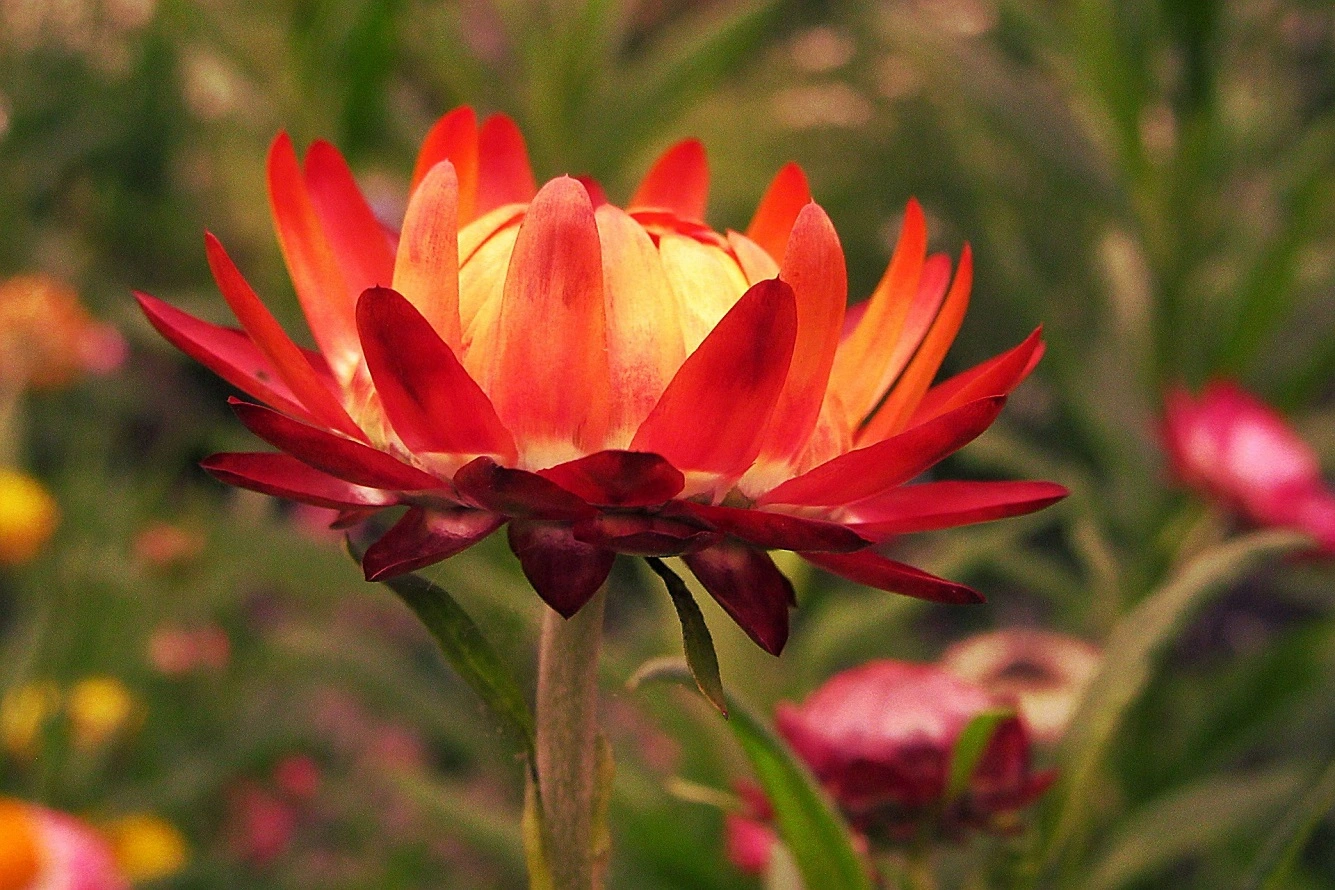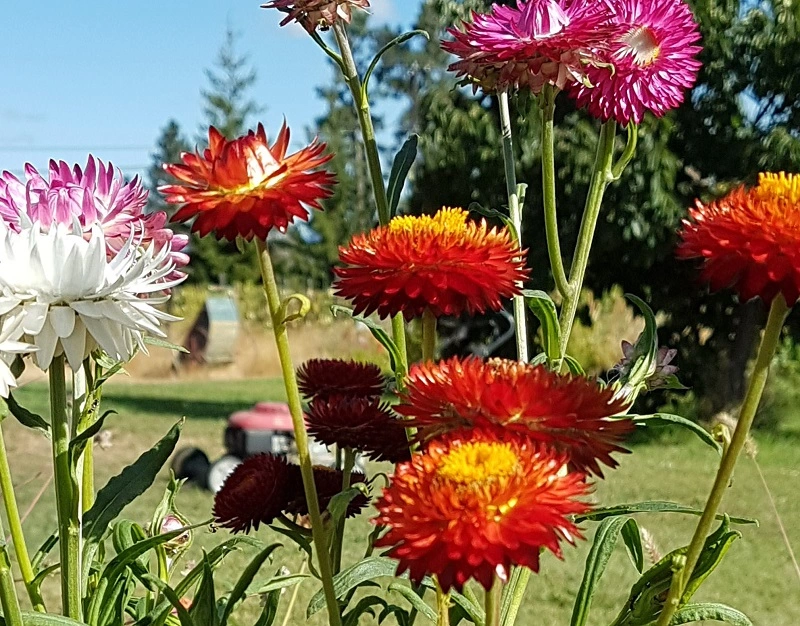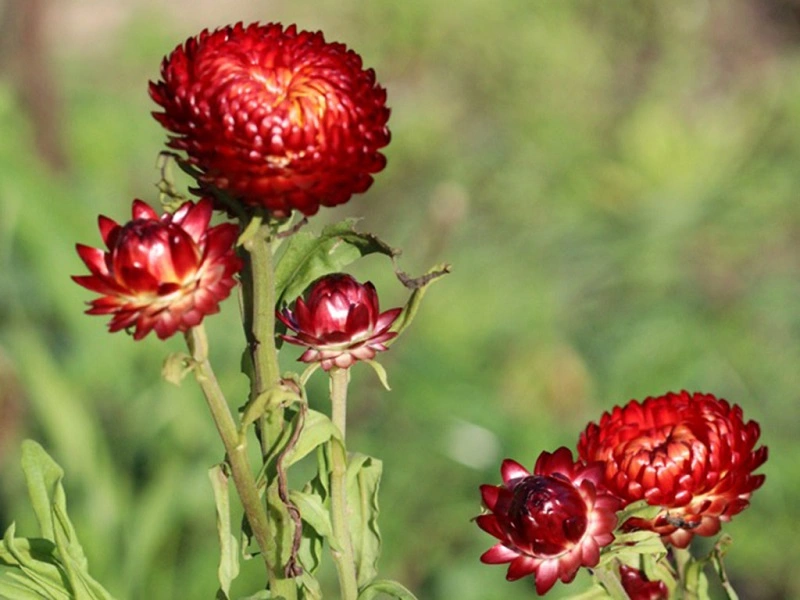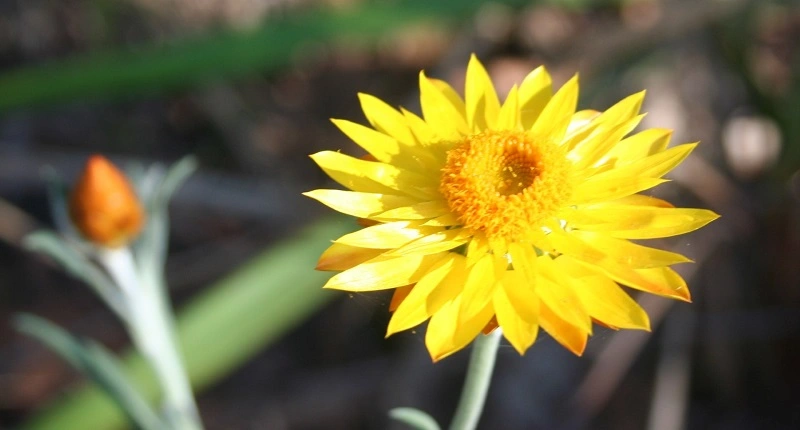Flor de la Paja - Aprende a Cultivar Hermosas Flores Perennes
Las flores de paja, también conocidas como Helichrysum, son plantas de la familia de las Asteráceas. Independientemente de la variedad, cada una prefiere las regiones cálidas. La planta es un elemento precioso de ramos y arreglos de jardín. Además, sus propiedades curativas se utilizan desde hace muchos años. La planta es fácil de cultivar. Por eso, a menudo la eligen los jardineros principiantes.

Strawflower - ¿qué tipo de planta es?
Los jardineros suelen referirse a la flor de la paja como siempreviva dorada. Su nombre científico es Xerochrysum bracteatum. Pertenece al grupo de plantas anuales que pueden alcanzar hasta 1 metro de altura. Sus tallos desarrollan muchas ramas y son relativamente fuertes, con hojas lanceoladas que crecen a los lados.
La floración de la flor de la paja comienza a principios de julio y dura hasta octubre, cuando la planta desarrolla una inflorescencia característica de unos 5 cm de diámetro. Las flores tienen distintos colores, según la variedad. La flor perenne dorada crece de forma natural en Australia, pero se hizo popular en todo el mundo gracias a sus propiedades.

¿Qué aspecto tiene la flor perenne?
El aspecto de la planta depende sobre todo de la variedad concreta. La planta crece de 20 a 100 cm de altura. La variedad de base desarrolla hojas estrechas y lanceoladas, de color verde oscuro. La flor de la paja florece con flores características. Dependiendo del cultivar, sus colores, así como la forma de las hojas difieren.
Las variedades de flor de paja más populares
La flor de la paja es una planta popular disponible en distintas variedades. Entre las strawflowers más populares se encuentran:
- Blanco plateado - tiene un hábito denso característico y hojas estrechas y astilladas; la planta desarrolla un aroma mucho más fuerte que la variedad base; crece hasta 30-40 cm; requiere protección adicional en invierno; la variedad prefiere lugares soleados con suelo seco y rocoso;
- Nana - es una variedad enana con hojas plateadas; este cultivar prefiere pleno sol, y sus flores son amarillas durante la época de floración.
Las variedades base de la flor de la fresa se diferencian por el color de sus hojas. He aquí los tipos más destacados:
- Hojas Doradas,
- Bicolor Amarillo Verde Hojas,
- Hoja verde azul

Strawflower - beneficios de la planta
Xerochrysum bracteatum es una flor perfecta para cultivar en un jardín. También es una brillante adición a los jardines rocosos. Las flores de paja secas son un elemento habitual de hermosos ramos. Pero la planta perenne también tiene otros usos.
El aceite de girasol se utiliza con fines medicinales desde tiempos inmemoriales. Se emplea en el cuidado de la piel, sobre todo para el tratamiento de la cuperosis. También acelera la cicatrización de heridas y la formación de cicatrices, gracias a sus propiedades regenerativas. El aceite de fresa reduce el número de radicales libres, responsables de procesos como el envejecimiento de la piel.

¿Cuáles son los requisitos de cultivo de la flor de la paja?
Esta planta es muy fácil de cultivar, incluso para los jardineros principiantes. Debe plantarse a principios de mayo. A la hora de elegir el emplazamiento, busque un lugar con muy buena exposición al sol. La flor de la paja prefiere suelos permeables, mejor si son arenosos y con contenido de humus. El suelo debe estar ligeramente húmedo y ser rico en todos los nutrientes necesarios para su correcto crecimiento.
El caso básico de la planta de la flor de la fresa consiste en vigilar su entorno. Cualquier mala hierba debe eliminarse con prontitud.
Cuidado de la planta perenne - riego y poda
Las flores de paja requieren un riego regular, no demasiado intenso. La frecuencia de riego debe ser mayor si la planta crece en un contenedor. La planta necesita riego sólo cuando la capa superior de la tierra se ha secado. Asegúrese de no mojar las hojas, ya que podría provocar el desarrollo de hongos nocivos.

Strawflower - cómo abonar la planta
La siempreviva no requiere un abonado intenso. Pero si quieres conseguir los mejores resultados, puedes optar por abonos con varios ingredientes para aportar todos los nutrientes necesarios. Utiliza la mezcla una vez cada semana o cada dos semanas.
Strawflower - cuidados de invierno
La flor perenne no tolera las bajas temperaturas. Asegúrese de trasladarla a un interior frío para el invierno - con una temperatura media de 10-15°C (50-59°F). El lugar también debe ser suficientemente luminoso. Si se dan estas condiciones, es probable que la fresa en maceta sobreviva hasta la próxima temporada.
Las variedades más resistentes pueden dejarse en el jardín durante el invierno. Asegúrese de protegerlas de las heladas.
¿Cómo se reproduce la flor de la paja?
La flor de la paja puede reproducirse de dos maneras. El método más sencillo es recoger las semillas. Puede plantarlas directamente en el lugar preparado, asegurándose de mantener un espaciado adecuado. La flor perenne también se puede multiplicar utilizando esquejes superiores. Hay que recogerlos en primavera y enraizarlos antes de plantarlos en el suelo.

📍 ¿Qué aspecto tiene la flor de la fresa?
La flor de la paja es una planta pequeña con flores de colores. Según la variedad, pueden ser amarillas, naranjas, rojas, rosas y moradas. Las hojas suelen ser estrechas y lanceoladas.
📍 Cuidado de la flor perenne: ¿cómo propagar la planta?
Las flores de paja son fáciles de propagar. La forma más sencilla de multiplicar esta planta es mediante esquejes. Recójalos y enraícelos en primavera; esto se aplica a las plantas cultivadas en interior. Las siemprevivas de exterior deben esperar a que pase la última helada.
📍 ¿Cuándo recoger flores de paja para ramos?
La temporada de floración de la flor de la paja dura de julio a octubre. Planifique la recolección de estas flores para el principio de la misma. Tenga en cuenta que la planta es una especie protegida en algunos países, así que asegúrese de no recoger flores de paja silvestres.
📍 ¿Cuándo plantar fresas?
Si desea sembrar flores de paja, programe esta tarea para principios de mayo. Recuerde el espaciado de 20-30 x 50 cm (aprox. 10 x 20 pulg.). Las primeras siemprevivas empezarán a florecer a principios de julio.
Artículos destacados




